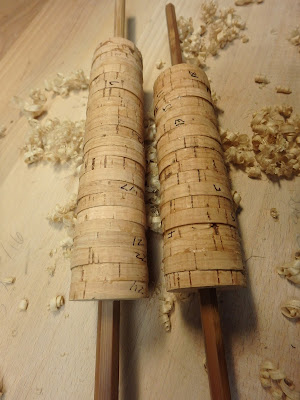So I have been building blanks and prepping strips for a couple weeks now without getting much else done. Built one prototype that I like for My own use. Scrapped a blank because I didn't like the taper. Going back to the tried and true version. I have a midge ready to glue now. That is the taper that I changed and didn't like. Have two other sets of strips that are roughed and heat treated for 6' rods.
 |
| Doesn't look like much now but, there are a few rods and reel seats in this pile. |
Prepping strips for tapering is the toughest and most time consuming part of the whole process of building cane rods. It will determine your end result (great, good or bad) depending on how well you do it.
What goes into prepping strips? Here are a few steps.
Find a culm that suits the rods you are building. Make sure there are no blemishes in the part of the culm you are going to use. It is a heartbreaker when you sand a glued blank and find a water mark or nick that you didn't see. If you try and use a culm that has dips and varying thicknesses it will be nothing but wasted time. You just can not use every culm.
 |
| Culms selected nodes staggered. I use blonde culms even for flamed rods when I can. |
File the outer node ring.
Flame low and slow. Trying to make an even color along the whole culm. This takes a while.
Split into as many even strips as possible.
 |
| I try to get 16 to 20 strips when splitting a culm |
Press nodes after sanding a relief area behind them. Get out all the doglegs and twists while straightening the sticks. This can take hours.
True up all the strips to get even edges.
Anything that is not straight and flat at this point will ruin your whole day later on. It will cause uneven angles, glue lines and chewed up strips in the beveler.
Now its time to run the strips through the beveler. The ends must be sharpened to a pencil point so you don't wreck the strips while feeding them. Here is where you find out how well you straightened and flattened your strips. If they are off you will have headaches. I bevel the strip to .050 over final dimension.
 |
| Ready to rough out the straightened strips. |
Next is heat treating. Oven temps must be even. Cooking times vary depending on the cane. Nothing written in stone here. You have to sit and watch the whole time making sure temps are on point and nothing is getting too hot.
If you have ever wandered why a bamboo rod is expensive look at the time put into it.
I will continue with the process in another post.
As always thanks.





















